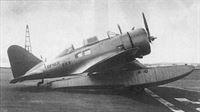Фотографии
-
The SEV-1XP (1st Experimental Pursuit), powered by a 900 h.p. P&W Wasp, was Seversky’s entry in the US Army Air Corps' pursuit (fighter) competition. It was unveiled in 1936 during an Aircraft Exposition in New York City’s Grand Central Palace, and later participated in races as the S-1, flown by company test pilot Frank Sinclair, who is seen on the wing in this picture. It came fourth in the 1937 Bendix Air race.
Самолёты на фотографии: Seversky P-35 - США - 1936
-
As a result of the Pursuit competition, 75 P-35s plus spares amounting to eight additional aircraft were ordered. Delivered to the Army Air Corps during 1936 and powered by 950 h.p. P& W Wasps, they had a top speed of 300 m.p.h. at 10,000ft.
Самолёты на фотографии: Seversky P-35 - США - 1936
-
Регистрационный номер: R70Y 36-year-old sportsman pilot Frank Fuller Jr took delivery of this S-2 racer in 1937, and won the transcontinental Bendix Race from Los Angeles, California, to Bendix, New Jersey, averaging 258-2 m.p.h. He won again in 1939 at 282-098 m.p.h. The S-2 had a 1,200 h.p. P&W R-1830-SC-8.
Самолёты на фотографии: Seversky P-35 - США - 1936
-
The Russian government purchased two Convoy Fighters in 1938, one SEV-2PA-L landplane, seen here, and one amphibian, and acquired production rights. They had 1,000 h.p. Wright R-1820-G3 Cyclones and could carry two 0-50in or 0-30in calibre machine-guns on the nose and two in the wings. A movable 0-50in calibre gun was fitted in the rear cockpit, and 250lb bombs could be carried on underwing racks.
Самолёты на фотографии: Seversky SEV-2PA / AT-12 - США - 1937
-
Регистрационный номер: NX1307 NX1307, the SEV-2PA-A amphibian for Russia, had an experimental 1,000 h.p. XR-1820 Cyclone.
Самолёты на фотографии: Seversky SEV-2PA / AT-12 - США - 1937
-
The 2PA-3B, which appeared in 1939, was an aerodynamically refined version of the Convoy Fighter with a long-range internal fuel tank and increased span. A Cyclone replaced the Twin Wasp.
Самолёты на фотографии: Seversky SEV-2PA / AT-12 - США - 1937
-
In 1937 the X-BT was re-engined with an 850 h.p. Wright R-1820-G2 Cyclone and offered as the SEV-2PA Convoy (i.e. Escort) Fighter. It had flaps and drooping ailerons.
Самолёты на фотографии: Seversky SEV-2PA / AT-12 - США - 1937
-
Регистрационный номер: X2106 [2] De Seversky extended the nose of the prototype and enlarged the canopy, making it the demonstration prototype for a basic trainer competition which it won, being produced as the BT-8.
Самолёты на фотографии: Seversky SEV-2XP / BT-8 - США - 1934
-
Регистрационный номер: X18Y The 2XP, apparently another development of the prototype 3XAR, appeared about 1935 for a USAAC pursuit/observation aircraft competition. It had a 1,000 h.p. Wright Cyclone and carried two in tandem.
Самолёты на фотографии: Seversky SEV-2XP / BT-8 - США - 1934
-
During 1936 and 1937 the USAAC took delivery of 30 BT-8s, plus five as spares. The engine was the 350 h.p. Wright R-975-E.
Самолёты на фотографии: Seversky SEV-2XP / BT-8 - США - 1934
-
The X-BT was proposed as a basic trainer but could also be configured for advanced training or combat. As a basic trainer it had long-span (41ft) wings and fixed undercarriage; 36ft-span wings and retractable undercarriage were fitted for the advanced trainer/fighter role. The engine was a 550 h.p. Pratt & Whitney Wasp.
Самолёты на фотографии: Seversky SEV-2XP / BT-8 - США - 1934
-
The BT-8 Special was a one-off modified BT-8 with a P-35 empennage and increased-span wings with dihedral. It lost to the North American BT-9 in the basic trainer competition.
Самолёты на фотографии: Seversky SEV-2XP / BT-8 - США - 1934
-
The 3XAR amphibian, powered by a 420 h.p. Wright Whirlwind, was built at the College Point, New York, factory of the Edo float company in 1933. It was de Seversky’s first American design, and the first aeroplane to employ an all-metal, stressed-skin cantilever wing. Its unique Edo amphibious undercarriage had floats which could be pivoted up and down hydraulically for sea- or land-based operations, and the wheels were supported directly from the wing, independent of the floats. The pilot was seated forward, with room for two passengers in the rear cockpit. De Seversky established an amphibian world speed record of 188 m.p.h. with the SEV-3 in 1933. Spanning 36ft, it had a 1,640ft/min rate of climb and a service ceiling of 20,000ft.
Самолёты на фотографии: Seversky SEV-3 - США - 1933
-
Регистрационный номер: X2106 [2] The original 3AXR in landplane configuration with large undercarriage trousers and a streamlined tailwheel fairing.
Самолёты на фотографии: Seversky SEV-3 - США - 1933
-
The prototype in its landplane form at North Beach Airport after a 750 h.p. Wright Cyclone had been installed.
Самолёты на фотографии: Seversky SEV-3 - США - 1933
-
The prototype in its amphibian form at North Beach Airport after a 750 h.p. Wright Cyclone had been installed. It set a new amphibian speed record of 230-413 m.p.h. in 1935, and set eight more world speed records in 1936 and ’37.
Самолёты на фотографии: Seversky SEV-3 - США - 1933
-
Three SEV-3M-WWs, powered by Wright Whirlwinds, were built for the Colombian Air Force, to operate from high-altitude fields and narrow rivers.
Самолёты на фотографии: Seversky SEV-3 - США - 1933
Статьи
- -
- Douglas DC-3 HB-ISC /Preservation Profile/
- Personal album. Military
- B.Robertson - An AID to quality (2)
- C.Du Cros, J.Flack - Spitfire reborn
- C.Prower - From Brisfit to Beverley: Sweepback research (8)
- D.Davies - Victor farewell
- H.Levy - Seversky (1)
- H.Shore - Flea fever (2)
- J.Stroud - Avro Tudor /Post-war propliners/
- J.Wilkinson, R.Fox - RAAF Heritage Flight
- M.Oakey - Grapevine
- M.Roffe, D.Baker - Great moments in aviation (2)
- M.Simons - Sling's sailplanes (12)
- P.Hearn - 50 years of parachute training
- P.Jarrett - By day and by night: Fairey Fox (1)
















